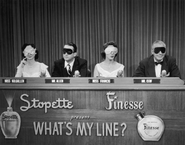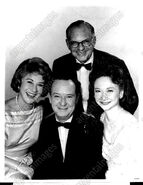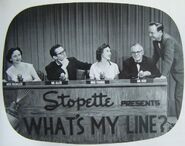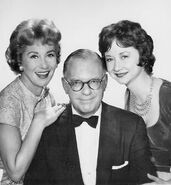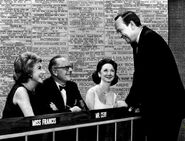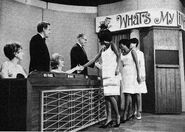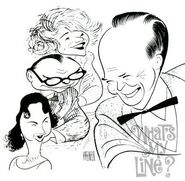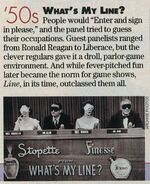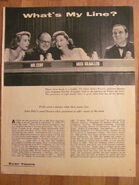| Aired | |
| CBS Primetime, February 2, 1950 – September 3, 1967 (876 Episodes) | |
| Run time | |
| 30 Minutes | |
| Host | |
| John Daly | |
| Origination | |
| Grand Central Studios, New York City, New York CBS Studios 52, 59, and 50, New York City, New York | |
What's My Line? was the long-running panel game show where the celebrity panelists try to figure out unusual occupations of everyday people. It's the long-running panel show that asks the question..."Is it bigger than a breadbox?"
This is chronicling the classic 1950 version of What's My Line?.
Game Format[]
Main Game[]
In each What's My Line? game, a contestant would enter the stage and sign in his/her name, by virtue of the host saying, "Will you enter & sign in please?" After that, he/she sat down at a desk next to the host. The game would begin by having the home audience be shown what's his/her line, and the host afterwards told the panel a clue which is usually "deals in a service" or "self-employed", something like those. Now the panelists in turn asked yes-or-no questions to the contestant which would hopefully lead to the right line. Each time the panelist in control got a yes answer, his/her turn continued, but if at any time the panelist in control got a no answer, he/she loses his/her turn and control passed to the next panelist in line; the contestant will also receive $5. Upon a no answer, the host would say the famous catchphrase "# down, # to go" (Ex: 2 down, 8 to go). Sometimes a question would have the host make a brief explanation which can lead to either a yes or no answer. A panelist can be allowed to pass his/her turn without penalty; other times the panel can call a conference. If the panel can guess the right line, they won the game, but if they got ten no answers, the contestant stumped the panel and won the game and a maximum total of $50. Often, the host would throw the cards over (end the game) when time was running short or any other reason.
Mystery Guest[]
After two rounds of What's My Line? were played, a third round was played but a little differently. For this round featured the appearance of the "Mystery Guest". This was where the panelists were blindfolded so they couldn't see the guest. The mystery guest entered and signed in as usual, and that's where the game began. As usual the panel asked yes or no questions, this time to try and guess the name of the mystery challenger. What makes this round more different is that this time each panelist can only ask one question per turn hence the rule "one question at a time", and they had two to three minutes to identify the guest. While all this was going on, the mystery guest disguised his/her voice in a variety of ways.
Some mystery guests wouldn't be famous from the entertainment field, but from other walks of life; when that happens, those guests would play in the main rounds; instead of writing their names, they would write down a big "X" referring to them as Mr. or Ms. "X".
Personnel[]
- Host: John Daly
- Substitute Hosts: Bennett Cerf, Eamonn Andrews, Clifton Fadiman
- Announcer: Lee Vines, Bern Bennett, John Briggs, Dick Stark, Hal Simms, Jack Clark, Johnny Olson, Ralph Paul
- Main Panelists: Arelen Francis, Bennett Cerf, Dorothy Kilgallen
- Producers: Gil Fates, Bob Bach
- Directors: Paul Monroe, Franklin Heller, Frank Satenstein
- Set Designers: Manuel Essman, John Ward, Robert Rowe Paddock, Willard Levitas
- Closing Theme – “Roller Coaster” by Milton DeLugg and Lou Burch


